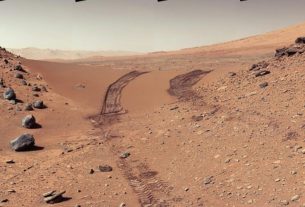You will probably not hear from Zhurong again for some time. The Chinese rover, which has been evolving on Mars for more than a year, has indeed just entered a dormant state due to the winter cold and local sand and dust storms. When should he resume service?
Do the round back while waiting for better soils
According to a statement from the Chinese lunar exploration program, Zhurong went into “hibernation” on May 18, when temperatures hover around -20°C during the day, before dropping to -100°C at night. These temperatures will continue to drop over the next few weeks.
The Tianwen 1 orbiter, which delivered the Zhurong rover into the Martian atmosphere a year ago, also detected several sand and dust storms forming over the landing zone with its medium-resolution camera. . That’s why Zhurong will hunker down for a while.
NASA’s Curiosity and Perseverance rovers will be able to continue their operations during the Martian winter, the latter being powered by radioisotope thermoelectric generators. It is a type of nuclear energy.
The Chinese rover is not alone in a difficult situation. Arriving on the Red Planet in November 2018, NASA’s InSight lander is also struggling to generate enough solar power to continue operations due to dust accumulating on its panels. For his part, Zhurong is able to tilt his own panels to maximize light gathering. It is also equipped with a special anti-dust coating.
This will therefore not be the end of the journey for China, unlike the American Insight mission, which has only a few weeks left to live on the red planet. Zhurong is expected to resume operations in December (early spring in the Martian Northern Hemisphere).
Remember that the objective of this mission is to learn more about the geology of the vast rocky plain of Utopia Planitia. This environment is indeed likely to have been the shore of an ocean several billion years ago.
To operate, Zhurong is equipped with two cameras that aim to take images of rocks. It also has a multispectral camera and a spectrometer equipped with laser technology to study their constitution. Finally, like Perseverance, Zhurong also offers ground-penetrating radar aimed at revealing the geological processes that led to the formation of the regions through which it travels.




